Creating emotionally impactful songs requires a delicate understanding of chord progressions.
Traditional folk music offers a unique showcase of chord structures that can trigger profound emotional responses.
Infusing these compositions into your songs can add depth and character.
This doesn’t imply that one should do away with common chord progression; rather, compliment them with folk influences.
The beauty of folk music lies in its simplicity and its ability to evoke emotions.
Thus, incorporating these elements can significantly enhance your songwriting process.
Table of Contents
- Folk Chord Progressions
- I – V – vi – IV (1-5-6-4)
- ii – V – I – IV (2-5-1-4)
- I – iii – vi – IV (1-3-6-4)
- I – IV – V – I (1-4-5-1)
- vi – V – IV – I (6-5-4-1)
- iii – IV – ii – V (3-4-2-5)
- IV – I – V – vi (4-1-5-6)
- I – IV – ii – V (1-4-2-5)
- I – iii – IV – V (1-3-4-5)
- I – IV – vii° – V (1-4-7-5)
- I – vi – ii – V (1-6-2-5)
- vi – IV – V – I (6-4-5-1)
- I – V – IV – ii (1-5-4-2)
- ii – IV – vi – V (2-4-6-5)
- IV – V – I – vi (4-5-1-6)
- The Bottom Line
Folk Chord Progressions
I – V – vi – IV (1-5-6-4)
A timeless progression, evokes profound sentiment for captivating storytelling.
The I-V-vi-IV chord progression is a common sequence in folk music, providing a poignant, emotional backbone to many songs. This progression often introduces a sense of melancholy or dreamy nostalgia, making it a powerful tool in songwriting to evoke deep emotions.
- Difficulty: Easy
- Example: C – G – Am – F (Key of C)
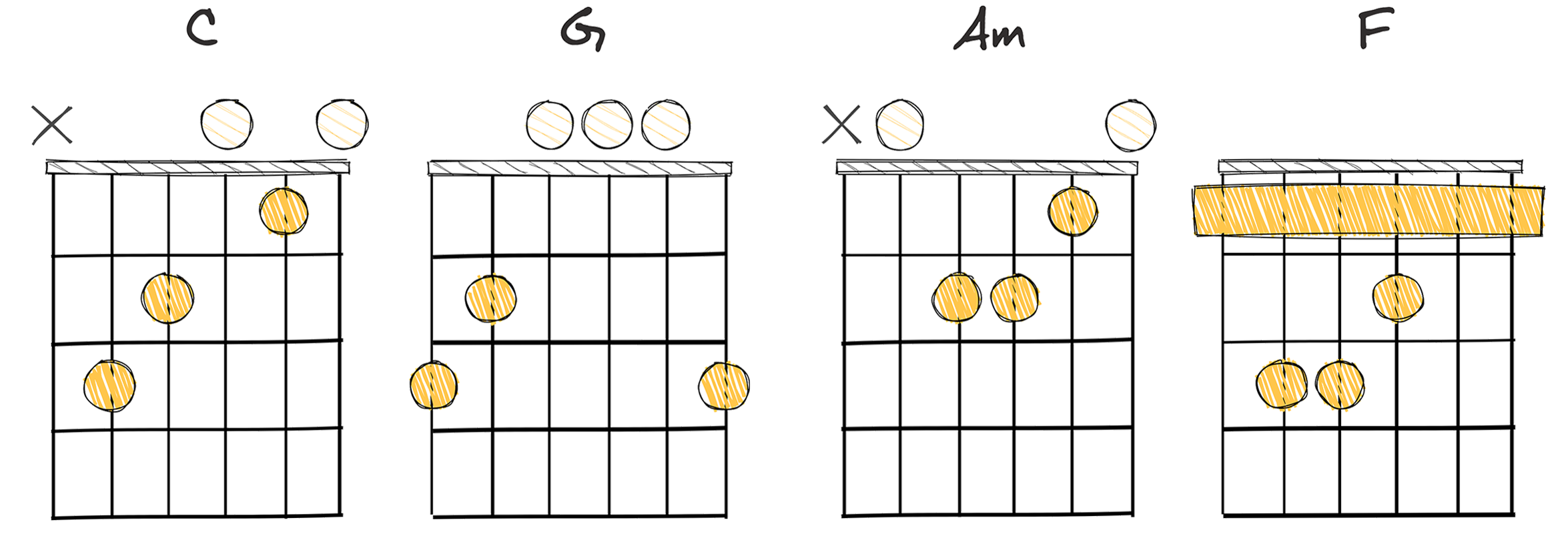
The I – V – vi – IV chord progression is one of the most common progressions in popular music.
The simplicity and familiarity of this progression brings a sense of comfort and nostalgia to listeners.
Often regarded as the “pop song” progression, it has been used in thousands of songs across several genres.
In the key of C major, this progression becomes C – G – Am – F.
This simple sequence of chords can churn out an unbelievably vast amount of songs, serving as the backbone of many timeless classics.
This progression is easy to play on multiple instruments, including the guitar and piano, making it a go-to for many musicians.
Emotionally, this progression can be used to convey a range of feelings depending on how the chords are played.
A slow, soft delivery of the chords can evoke feelings of sadness or longing.
Alternatively, a fast, vibrant performance of the chords can infuse a sense of exhilaration or happiness into the song.
The repeated cycling from major to minor chords also creates a pull between happiness and sadness, adding depth to the song’s emotional landscape.
Interestingly, the I – V – vi – IV progression has deep roots in folk music.
While it’s often associated with pop music today, many classic folk songs and ballads utilize this chord progression.
It is undeniably a magical progression that has been loved and adopted by countless musicmakers through the ages.
ii – V – I – IV (2-5-1-4)
This progression adds a poignant emotional depth to folk melodies.
The ii – V – I – IV chord progression is a powerful element frequently used in folk music to add depth and evoke emotions. This sequence of chords not only offers a sense of resolution and closure, but it can also imbue a sense of nostalgia, longing, and sentimental feelings in your music.
- Difficulty: Intermediate
- Example: Dm – G – C – F (Key of C)
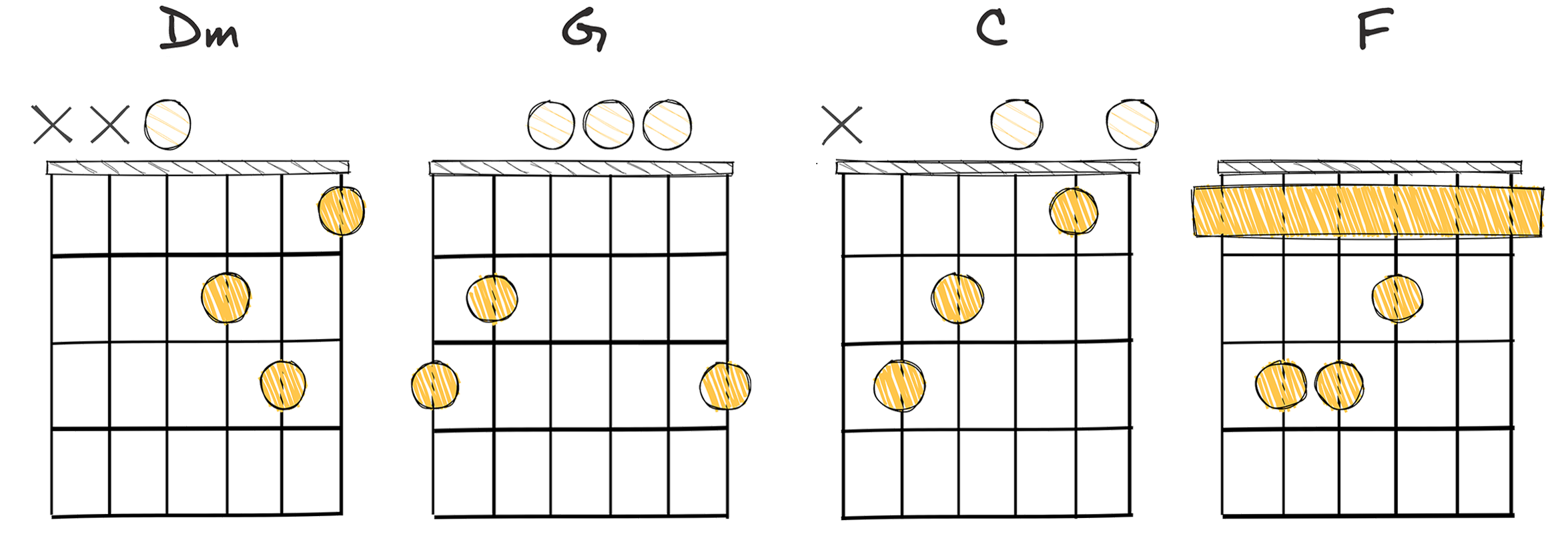
The ii – V – I – IV (2-5-1-4) chord progression is a common sequence found in folk music, often used to create a sense of emotion and drama within songs.
Rooted in the tradition of folk music, this chord progression has a rich history which parallels the evolution of folk music as a genre.
Emphasizing the intermediate level of play, mastering this chord progression goes beyond just strumming the chords.
It requires an understanding of the progression’s underlying musical theory.
A fundamental component to consider in the ii – V – I – IV progression is the interval relationships between chords.
These intervals play a crucial role in establishing the progression’s distinctive emotional quality.
Before discussing the specifics of this progression, it’s essential to have an understanding of what a chord progression is.
Simply put, chord progressions are a series of chords played in order, providing the harmonic structure of a song.
Understanding the theory behind the ii – V – I – IV chord progression is key to infusing your folk songs with deep emotion.
Scholars of music agree that the theory behind chord progressions, and this one in particular, adds a rich and complex emotional layer to a song.
Recognizing and understanding these theories allows musicians to intentionally manipulate listener’s emotions through their song choices.
This specific progression, starting with the II chord, creates a feeling of anticipation before resolving back to the tonic, or home key, adding tension and emotion to the song.
The beauty of this progression, as well as many others in folk music, lies in its versatility.
It can be interpreted in a variety of ways and thus has the ability to convey a wide range of emotions.
This variation depends heavily on the arrangement and rhythm used by the artist, highlighting the progression’s ability to be adapted fully to ignite the intended emotion.
I – iii – vi – IV (1-3-6-4)
This progression offers an emotional and melancholic mood.
The I – iii – vi – IV chord progression is a versatile and emotionally stirring sequence commonly used in folk music, but also prevalent across multiple genres. Its strength lies in its ability to evoke strong feelings in the listener, making it an excellent tool for enhancing the emotional impact of a song.
- Difficulty: Easy
- Example: C – Em – Am – F (Key of C)
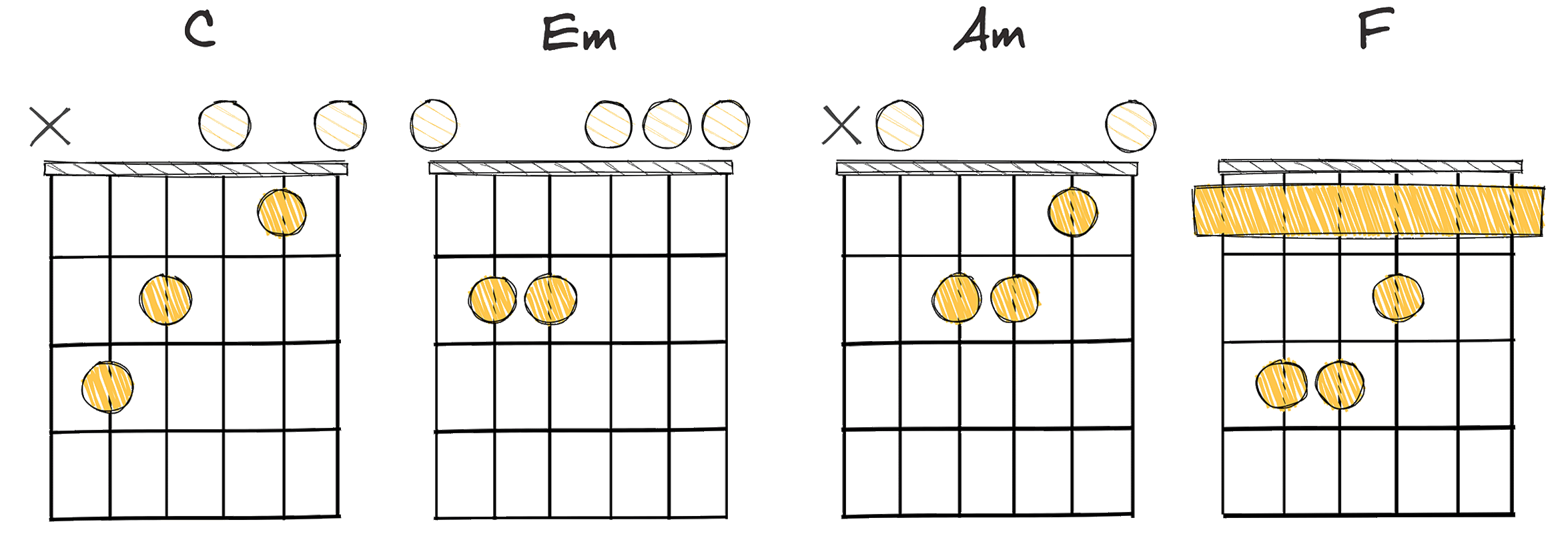
Though perhaps not as widely recognized as some other sequences, the I- iii- vi- IV chord progression holds a special place in the heart of many songs, lending itself to an emotional and refreshing sound.
This chord progression, notated in Roman numerals as I – iii – vi – IV (1-3-6-4), can be expressed as C – Em – Am – F in the key of C.
A compelling aspect of this progression is its blend of major and minor chords.
It creates a musical journey that is both uplifting and touched with melancholy, making it engaging for musicians of all skill levels.
The I-iii-vi-IV progression begins on the tonic major (I), introducing a clear and vibrant start.
It then moves to the iii chords, a subtle shift to a minor chord, instilling a feeling of longing or contemplation.
Following this, the progression ventures into the vi chord, deepening the sense of nostalgia or reflection before resolving to the IV chord, offering a hopeful resolution.
The continuous flow between hope and reflection in this progression makes it a remarkable tool for weaving complex emotional tapestries in music.
One of the charms that set this progression apart is the captivating harmony it produces.
The transitions from the I chord to the iii chord, from the iii chord to the vi chord, and from the vi chord to the IV chord create an elegant, resonant cascade of sounds that can touch the soul.
Modern and traditional songs across various genres have found inspiration in this progression, as it seamlessly lends itself to diverse lyrical themes and rhythmic patterns.
The I – iii – vi – IV chord progression continues to inspire musicians and songwriters with its unique expressive range and musical versatility.
In essence, the balanced blend of joy and sorrow within the I – iii – vi – IV progression makes it an intriguing choice for creative exploration, capable of painting vivid emotional landscapes through the combination of melody, rhythm, and words.
Its quiet presence in various musical traditions emphasizes its ability to communicate emotions in a way that resonates deeply with listeners, demonstrating the timeless power of a well-chosen chord progression.
I – IV – V – I (1-4-5-1)
Classic progression lending soulful resonance to folk song narratives.
The I-IV-V-I progression is a staple in folk music, known for its simplicity and emotional resonance. These chords provide a pastoral and nostalgic feel, lending themselves perfectly to storytelling, a key component of folk songs.
- Difficulty: Easy
- Example: C – F – G – C (Key of C)
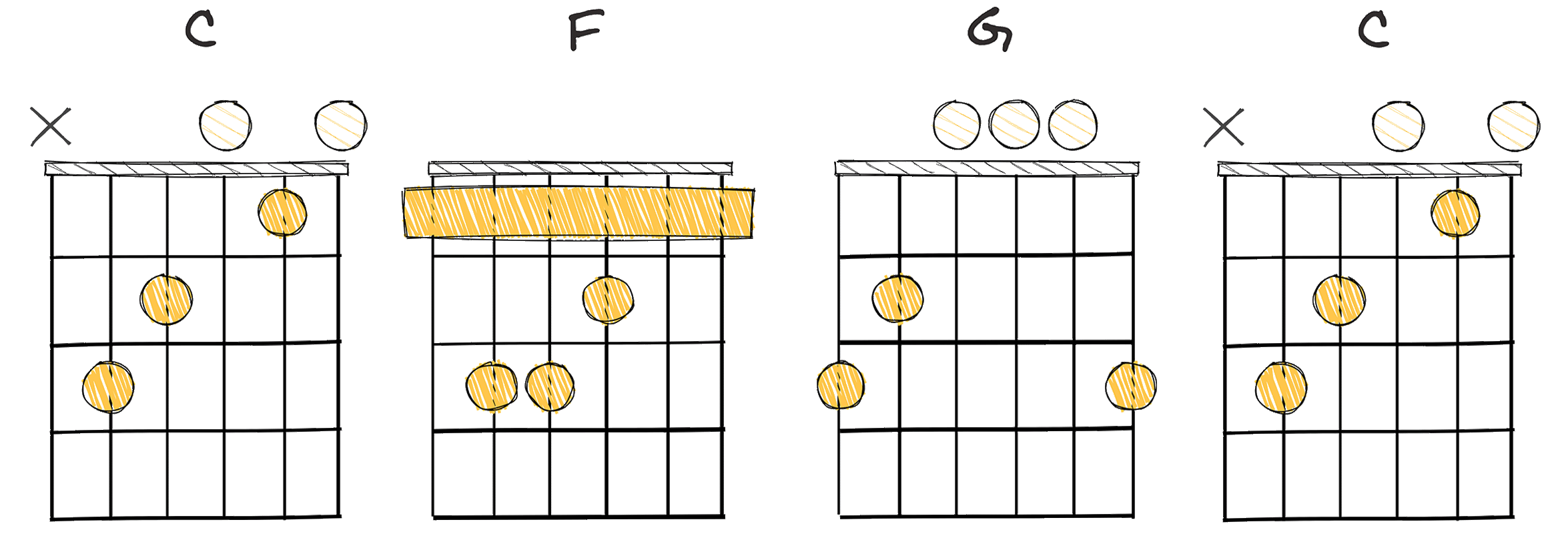
The I – IV – V – I (1-4-5-1) progression is one of the simplest yet most influential chord progressions in the world of music.
It has been present in various genres and epochs, from classical music to rock ‘n’ roll, highlighting its timeless popularity among songwriters and composers.
Understanding its structure is integral to delving into the emotional potential that it brings to any song.
The I – IV – V – I progression is extremely easy to play, making it ideal for folk music where the emphasis is more on the stories and messages in songs.
This progression begins on the tonic or the first note of the scale (I), transitions to the fourth note (IV), then the fifth (V), finally returning to the tonic.
This creates a musical circle that is felt both harmonically and emotionally.
The real strength of this progression lies in its perfect cadence (V – I), which delivers a sense of finality and resolution favorable to a myriad of emotional themes.
This resolution, typically at the end of a musical phrase or piece, carries a strong harmonious and emotional satisfaction that listeners intuitively recognize.
It provides a sense of closure while allowing the music to flow seamlessly if the structure repeats.
Talk about the range from finality to infinity, this progression can create various moods depending on how composers or songwriters deploy it.
In folk music, the chords’ simplicity lets the listener focus more on the storytelling element, enhancing its emotional impact.
Understanding and utilizing the I – IV – V – I progression allows a songwriter to access a powerful tool in expressing various emotions through their music.
Therefore, whether it is driving the melody forward or supporting the scene-setting lyrics, this progression is the backbone of many memorable and emotionally resonant folk songs.
vi – V – IV – I (6-5-4-1)
This progression is poignant, exuding raw emotion in folk harmony.
The vi – V – IV – I chord progression, denoted as 6-5-4-1, is a common sequence in folk music, renowned for its capacity to evoke deep emotions. Known for its simple yet profoundly emotive characteristic, it involves the transition from the sixth, to the fifth, to the fourth, and finally to the first scale degree, adding a depth and evocative layer to the musical piece.
- Difficulty: Easy
- Example: G#m – F# – E – B (Key of B)
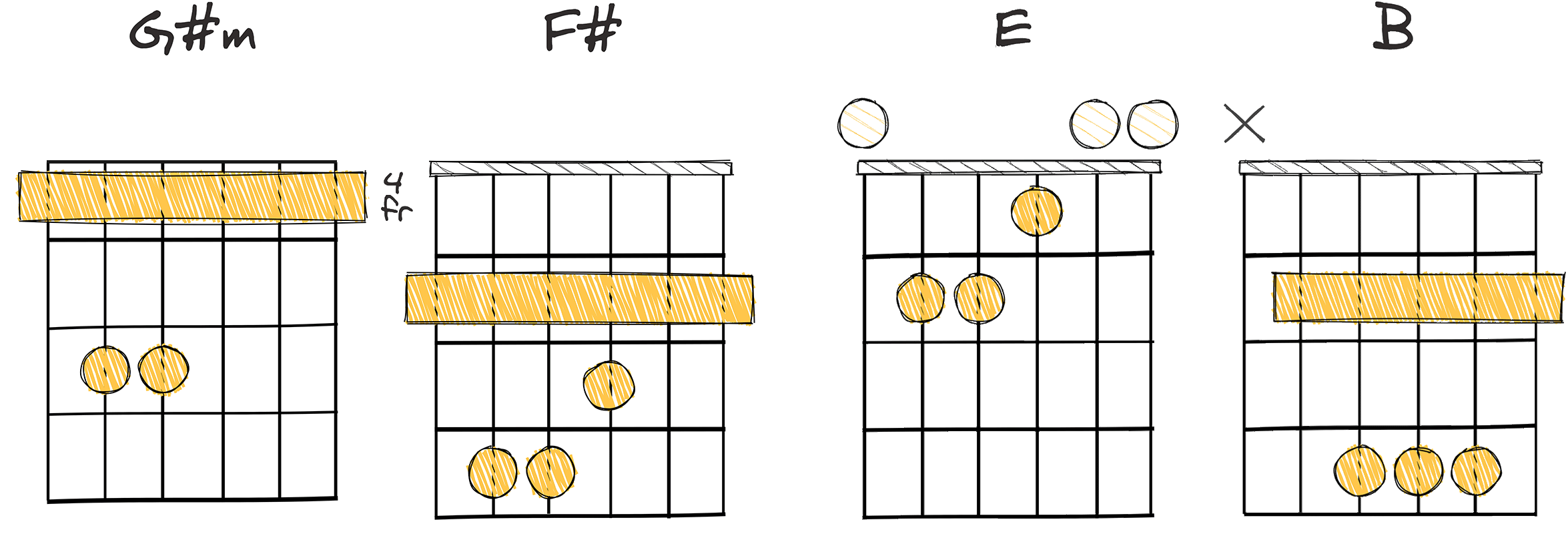
One of the most expressive chord progressions in the realm of folk music manifests itself in the form of the progression vi – V – IV – I or, to translate it to a specific key, G#m – F# – E – B in the key of B.
The backbone of countless songs across different genres, the unique resonating attribute of this progression is its ability to convey a wide range of emotions.
Folk musicians have found an ally in this chord progression, using it to articulate emotional narratives that range from solemnity and sorrow to joy and celebration.
The history of this progression dates back to the early roots of folk music itself, where musicians would weave stories of their daily lives into their melodic fabric, and the progression proves to be an exceptionally easy one to play, further enhancing its popularity.
Indeed, the simplicity of this progression permits even beginners to pick up the guitar and start strumming the strings to create a beautiful melody effortlessly.
This makes the vi – V – IV – I progression an ideal choice for those just commencing their musical journey.
While simple, it’s important to recognize that it’s the emotional depth this progression offers is not by any means bound by its simplicity.
To understand the power of this progression, it is helpful to dissect it and analyze its components in the context of folk music.
The vi chord (G#m in the key of B) brings a minor quality, inducing a sense of melancholy or reflection, acting as the impactful opening statement of the progression.
Moving on to the V chord (F# in the key of B), it injects a sense of tension into the progression, giving it a sense of expectation and anticipation.
The IV chord (E in the key of B) is traditionally associated with feelings of stability, resolution and reassurance, guiding the music towards a resolution.
Finally, the I chord (B in the key of B) is the grand finale, providing a satisfying, complete resolution and helping to establish the key of the song.
iii – IV – ii – V (3-4-2-5)
The iii-IV-ii-V progression offers complexity, innovation, and emotional resonance..
The iii-IV-ii-V chord progression, often explored by adventurous musicians, unveils a landscape rich in emotional nuance and harmonic creativity. Its blend of major and minor chords introduces unexpected twists that can captivate listeners.
- Difficulty: Easy
- Example: D#m – E – C#m – F# (Key of B)
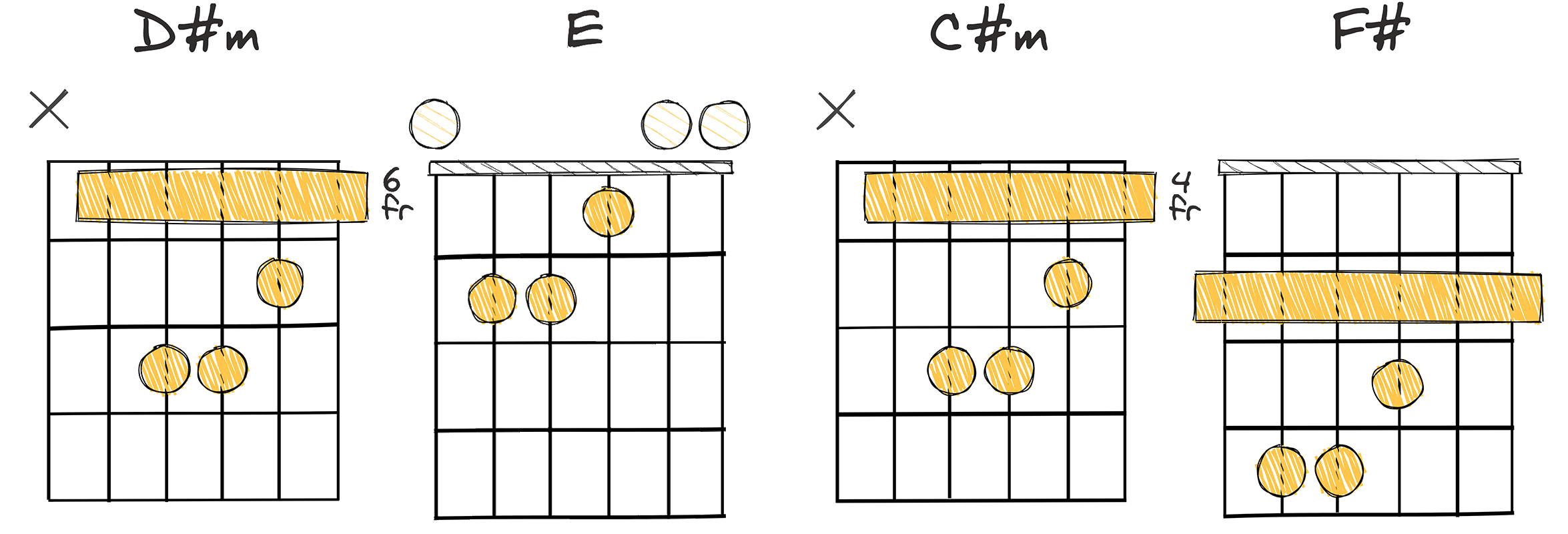
The iii – IV – ii – V (3-4-2-5) chord progression, exemplified by the chords D# minor – E major – C# minor – F# major in the key of B major, emerges as an unconventional and imaginative sequence found in innovative musical compositions.
Venturing beyond typical musical paths, this progression invites creativity and surprise into the musical tapestry, resonating with listeners searching for something fresh and different.
Rooted in a blend of diverse musical traditions, the iii – IV – ii – V progression lends itself to a unique harmonic narrative that can ignite a wide array of emotions.
Because of its unexpected twists and turns, this chord progression may be used in pieces that wish to provoke thought, stir feelings, or create an unconventional musical journey.
Its unpredictability offers a new listening experience, allowing listeners to explore and enjoy the melody’s complexity, fostering a deeper connection with the music.
Additionally, the combination of major and minor chords within this progression captures a mixture of longing, hope, tension, and resolution, adding a multifaceted emotional layer to compositions.
When played with expressive dynamics, this chord progression unfolds a rich, textured rhythmic landscape that can guide the flow of a song in new directions.
Switching between the chords may present a more complex challenge for musicians, making it an appealing choice for those looking to experiment and grow their skills.
Despite its nontraditional structure, experienced composers might find this progression a fertile ground for innovation, giving life to pieces that are emotionally compelling and artistically bold.
Creating a sense of intrigue and wonder due to its unorthodox arrangement, this chord progression can evoke feelings ranging from contemplation to exuberance, depending on its execution.
By manipulating rhythmic patterns, tempo, and song structures, musicians can craft an entirely distinct mood and character through the iii – IV – ii – V progression.
This versatility endows it with a special appeal to adventurous songwriters across genres, whether sculpting an experimental jazz piece, a reflective ballad, or a pioneering pop melody.
In essence, the inherent complexity and creative potential of the iii – IV – ii – V progression make it a fascinating tool in modern musical composition, capable of unlocking new horizons and inspiring novel expressions of human emotion and thought.
IV – I – V – vi (4-1-5-6)
This progression emits a poignant emotional punch, commonly used in folk.
This chord progression is a classic in folk music, utilized for its emotive and evocative potential. The journey from the IV to I creates a satisfying resolution, the I to V builds tension, while the transition to vi introduces a melancholic and sentimental mood to the progression, making it ideal for songs with an emotionally charged narrative.
- Difficulty: Easy
- Example: E – B – F# – G#m (Key of B)
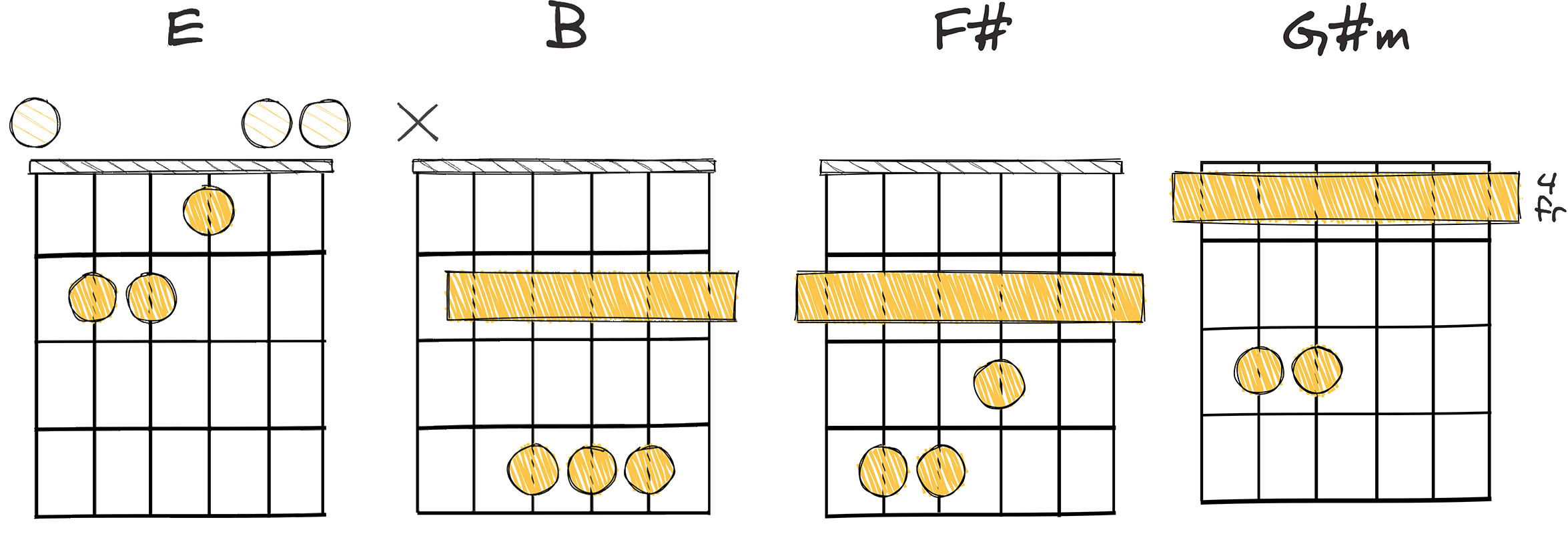
Within the evolution of music, different types and styles have come about, each with their unique components, and none more so than the powerful yet warm subgenre of Folk.
The chord progression IV – I – V – vi, (or as we know it in key of B, E – B – F# – G#m), in particular, has played a major part in crafting the emotional tone that Folk music is known for.
It is an often-used progression in Folk music due to its innate ability to evolve and shift the mood of a song.
This progression, though simple to play, offers a great deal of complexity when it comes to emotion conveyance.
The progression’s first chord, IV (E in the key of B), brings about a sense of anticipation, a feeling of expectancy, drawing the listener in.
Instead of starting at the root of the scale (I), beginning at the IV instantly establishes a distinct tonal center that prepares the listener for the journey ahead.
When transitioning to the second chord in this progression, I (B in the key of B), the sense of resolution is perceived, creating an emotional contrast with the feeling of suspense initially brought about by the IV chord.
This process of creating a tension and releasing it is an effective technique used in this chord progression to evoke strong emotional responses.
Moving on to the third chord in this progression, V (F# in the key of B), the tension once again builds up, albeit slightly, giving a feeling of suspense and uncertainty.
Interestingly, this chord is considered a dominant chord, tending towards leading the progression back to the root chord (I), thereby catching the listener off-guard when it instead leads to the vi chord.
The final chord in the progression, vi (G#m in the key of B), delivers an unexpected melancholic twist, significantly amplifying the emotional range of the song.
This chord is the relative minor to the I (B) chord, and its incorporation in the progress disrupts the listener’s expectation of resolution, reinforcing the profundity of the emotional voyage.
This chord progression, easy to play yet rich in emotion, has stood the test of time and remained a favorite amongst songwriters.
Many popular and influential folk songs utilize the IV – I – V – vi progression, each having its unique interpretation of the chord progression.
I – IV – ii – V (1-4-2-5)
Evoke deep emotions with this classic, heartfelt folk progression.
This I – IV – ii – V chord progression, often found in folk music, is renowned for its emotionally resonant and expressive qualities. The progression’s shift from major to minor chords creates an engaging melodic contrast, making it a popular choice for songwriters looking to infuse their compositions with deep, affective undertones.
- Difficulty: Easy
- Example: C – F – Dm – G (Key of C)
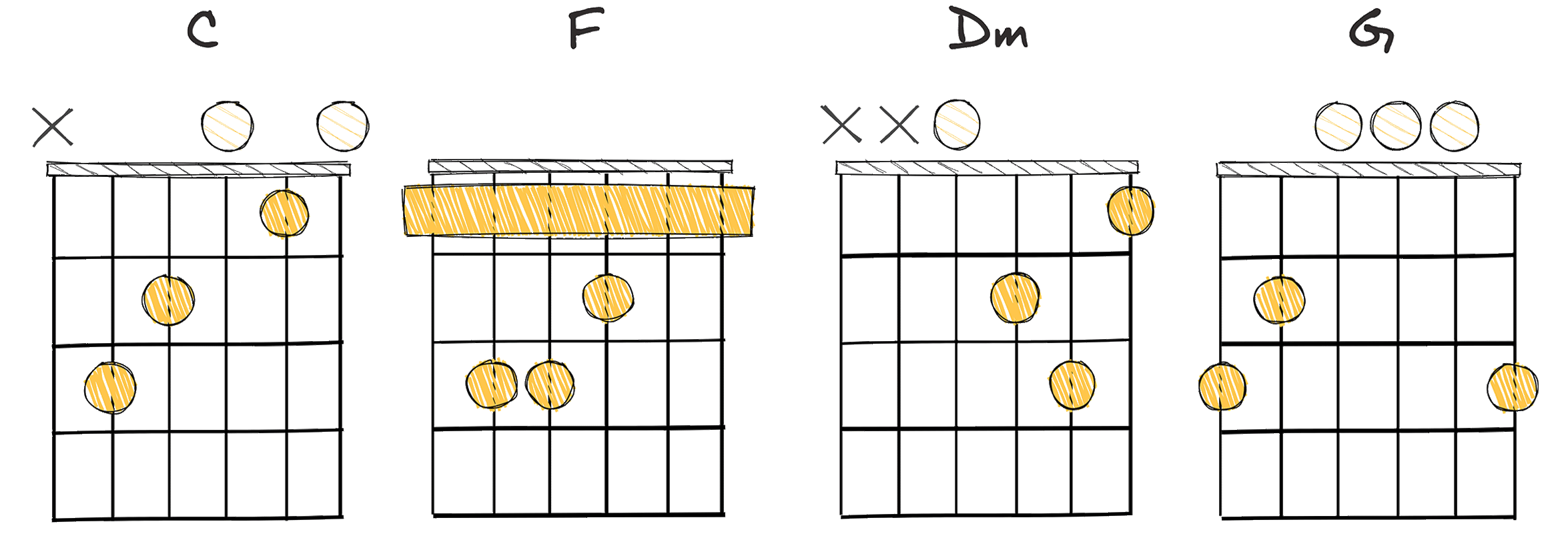
The I – IV – ii – V (1-4-2-5) chord progression can be observed in a multitude of genres, however in the realm of folk music, it particularly stands out.
This progression, often regarded as an easy chord progression, resonates with simplicity and yet carries a profound range of emotions, making it a favorite among many folk songwriters.
Being consistent with its backbone of harmonies, the I-IV-ii-V progression aids in effectively capturing the raw emotive essence that folk songs are renowned for.
This consistency and ease of playing allow musicians, especially beginners, to focus on the emotive narrative of the song.
It’s this contextual versatility inherent in the I-IV-ii-V progression that gives it a timeless appeal across generations of folk music.
Historically, the I-IV-ii-V chord progression can be traced back to the roots of folk music, indicating its long-standing influence on the genre.
It’s interesting to note that despite its simplicity, the progression provides an underlying structure that inspires countless melodious journeys.
In the key of C, it translates to C – F – Dm – G, providing a melodious balance that is both entrancing and comforting.
Furthermore, the progression’s inherent flexibility allows it to adapt to – and enrich – a varied range of storytelling approaches often present in folk songs.
Such flexibility is evident in the ability of the I-IV-ii-V to lend a sense of movement and fluidity, while staying within confines of simplicity.
Consequently, the I-IV-ii-V progression provides a robust harmonic basis for an effective emotional journey – a journey that is central to the ethos of folk music.
While the engagement of chords has evolved with time, the I-IV-ii-V continues to fashion itself to the traditions of folk music, staying relevant across varied musical landscapes.
Timing and anticipation are key elements in creating the emotive response expected from a folk song with this progression.
I – iii – IV – V (1-3-4-5)
A classic folk chord progression that evokes deep emotions.
This chord progression, I – iii – IV – V (1-3-4-5), often used in folk music, provides a simple yet emotional essence to a song due to the transition from a major tonality to a minor. It is both versatile and melodically interesting, lending your music a poignant and nostalgic atmosphere.
- Difficulty: Easy
- Example: C – Em – F – G (Key of C)
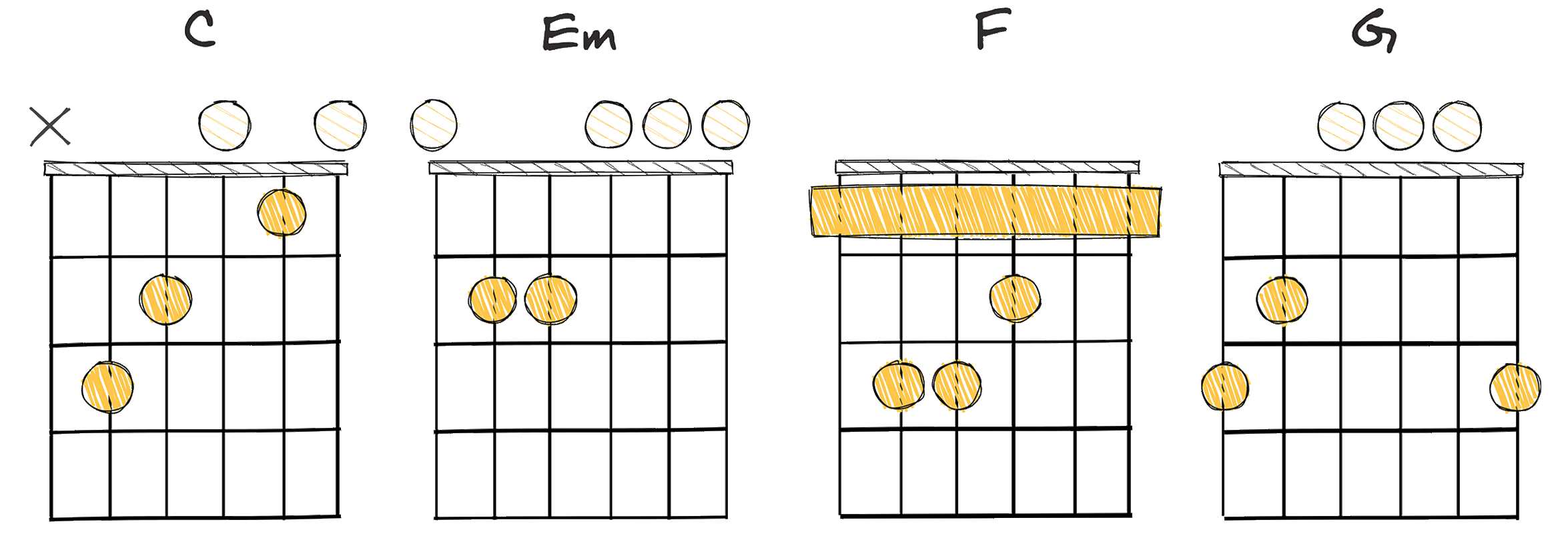
The I – iii – IV – V (1-3-4-5) chord progression is one of the many developments that have significantly shaped the landscape of folk music over time.
This progression is often applied by folk musicians to express profound emotion in their songs.
Writing songs in I – iii – IV – V progression enables the composer to infuse emotion naturally and comfortably.
This is directly tied to the flexibility this progression offers.
It allows an intuitive flow of chords from I to iii, on to IV, and then V, creating a milieu of both anticipation and resolution that can evoke a wide range of emotion in listeners.
On your guitar or piano, you’ll immediately notice how this progression has a smooth, fluid movement that seems to naturally cascade from one chord to the other.
This progression, I – iii – IV – V (1-3-4-5), when translated into the Key of C becomes C – Em – F – G.
When strings of these chords are played together, it often results in a gratifying blend of sounds that stir emotions.
You can try out this progression in your own songs and you might be pleasantly surprised by the depth and range of emotion that it can allow you to express.
Besides, the fact that this chord progression is variations of Easy to play chords, makes it readily accessible to even novice musicians.
This is arguably one of the reasons why this progression has endured in popularity within the folk genre over many decades.
Looking back at the history of folk music, it’s obvious how much the genre has relied on this progression to convey the desired themes and emotions.
It is this compelling ability to produce a wide, yet precise, range of emotions, that has made the I-iii-IV-V progression invaluable to folk musicians all around the world.
So, whether you’re a seasoned song composer or an aspiring musician, understanding and experimenting with the I – iii – IV – V progression can further enrich your musicality and infuse deep emotion into the songs you create.
I – IV – vii° – V (1-4-7-5)
Dynamic and engaging, this sequence adds tension and harmonious resolution.
The I-IV-vii°-V progression begins with a stable tonic, then expands to the fourth. The diminished seventh adds tension, intriguingly resolved by the dominant fifth. Its mix of stability and tension offers expressive, engaging musical narratives.
- Difficulty: Intermediate
- Example: C – F – Bdim – G (Key of C)
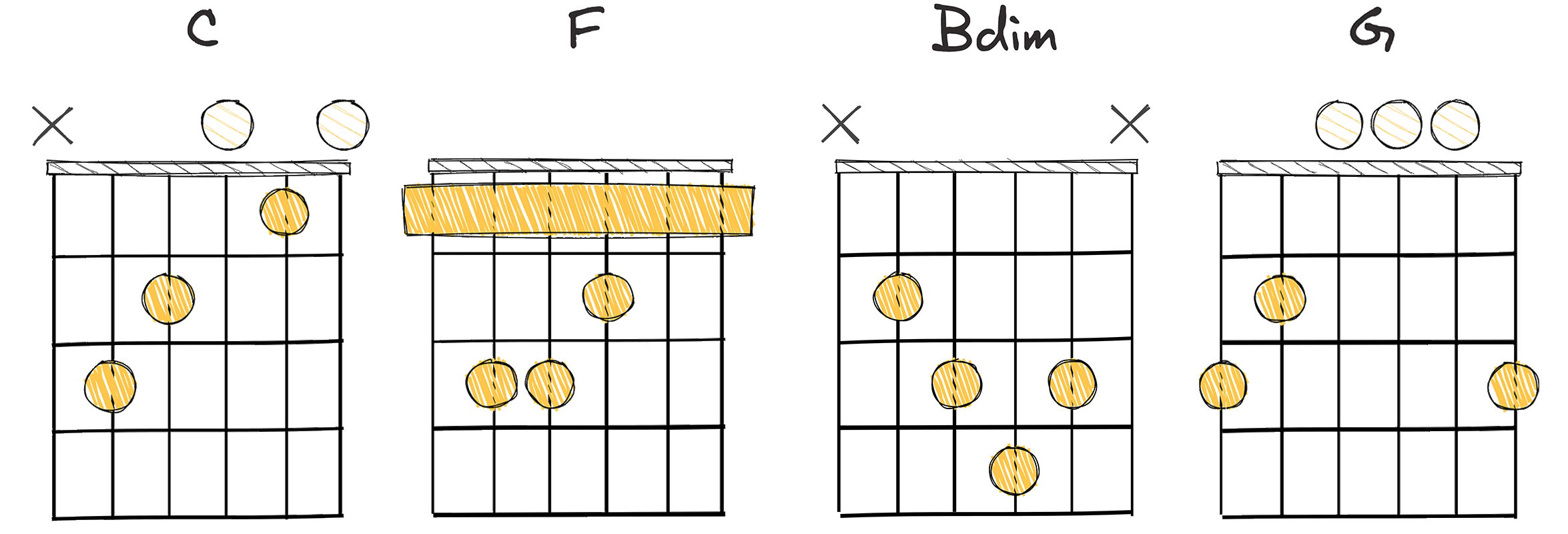
The chord progression I – IV – vii° – V (1-4-7-5) holds a unique place in folk music, resonating with the genre’s emphasis on storytelling and emotional expression.
With a structure that encompasses C – F – B diminished – G in the key of C major, this progression has a complexity that can provide songs with a rich, evocative quality, perfect for the narrative-driven nature of folk music.
The history of the I-IV-vii°-V progression, although not as widely recognized as some others, has found its home in the world of folk, and its use has only grown with time.
This progression’s appeal lies in its harmonic balance and tension.
The vii°, or diminished chord, adds a touch of dissonance, creating an emotional peak that resolves beautifully into the dominant V chord.
The inherent tension and resolution within the progression make it a powerful tool in conveying the thematic nuances often found in folk tales and songs.
It lends itself to tales of hardship, hope, and the human condition, core themes in folk music.
Beginner musicians and seasoned artists alike find value in this progression.
Its versatility in accommodating different vocal ranges and its ability to create various moods adds to its widespread appeal.
This icon, the I-IV-vii°-V progression, serves as an extraordinary vessel for musical expression, particularly in the folk genre.
When utilized with an understanding of its emotional potential rather than a mere formula, it opens up creative horizons, allowing artists to weave complex stories and emotions, thereby enriching the timeless tapestry of folk music.
I – vi – ii – V (1-6-2-5)
Embrace this progression for a nostalgic, emotional folk vibe.
The I-vi-ii-V chord progression, commonly referred to as the 1-6-2-5, is a mainstay in the world of folk music, often utilized for its ability to evoke deep, emotional responses from the listener. This progression’s appeal lies in its inherent melodic versatility and tension-release dynamic, making it an excellent tool for songwriters looking to infuse their compositions with depth and feeling.
- Difficulty: Intermediate
- Example: C – Am – Dm – G (Key of C)
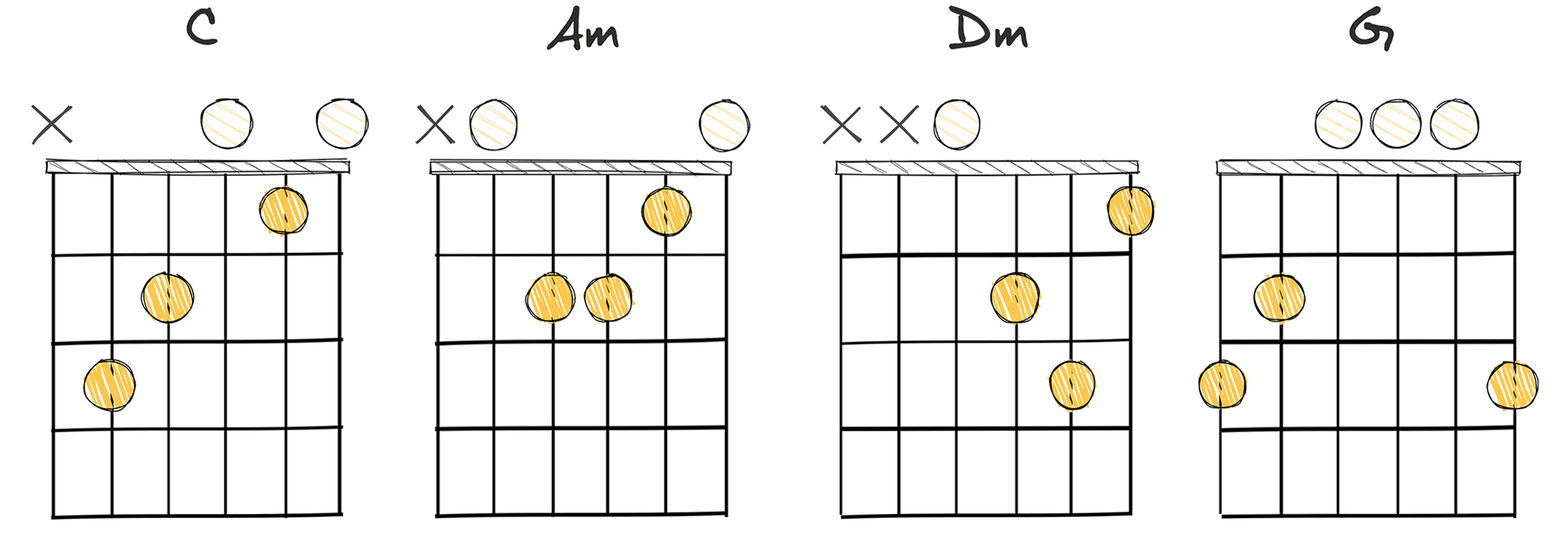
When it comes to Folk Chord Progressions one of the most touching and emotional progressions is the I – vi – ii – V progression, otherwise known as C – Am – Dm – G in the key of C.
This chord progression provides a sense of emotional storytelling that is a key characteristic of many folk songs, providing both a uplifting and melancholic feeling that can touch the audience deeply.
What makes this progression so captivating is its interplay between major and minor chords, creating a complex emotional landscape that can evoke a variety of feelings in listeners.
Indeed, the dynamics between the hopeful major chords and the more melancholic minor chords in this progression are what set the stage for the emotive power of folk music.
It is the emotional intensity that these types of chord progressions can create that makes them such an integral part of the folk genre.
If we delve into the history of this progression, we find that it has been a staple in folk music for decades.
Being based on the interplay between major and minor chords, this progression allows for a wide range of emotional expression, making it a favorite of many folk songwriters.
Given its ability to convey complex emotions, it’s not surprising that this progression has also been featured in numerous popular songs throughout the years.
Mastering this chord progression is not without its challenges.
It is rated as an Intermediate progression, requiring a certain degree of skill and knowledge to execute correctly.
But despite the level of difficulty, with ample practice and understanding of how each chord function to affect emotion, a musician can effectively convey the emotions encapsulated in the progression.
Indeed, it’s the fundamental understanding of the interplay between these chords that would enable a musician to utilize its full emotional potential.
Hence, the I – vi – ii – V progression is truly a remarkable tool for any folk musician looking to infuse more emotions into their songs.
Despite its complexity and the skill it requires to master, its potential for emotional storytelling makes it a progression any serious folk musician should consider incorporating into their songwriting.
vi – IV – V – I (6-4-5-1)
A timeless progression invoking deep emotion in folk music narratives.
The 6-4-5-1 progression is a prevalent chord sequence in folk music that often infuses songs with a sense of heightened emotion. This progression’s journey from a minor chord through two major chords to a resolving tonic can create a dramatic musical narrative that draws listeners into the emotional heart of your song.
- Difficulty: Easy
- Example: Am – F – G – C (Key of C)
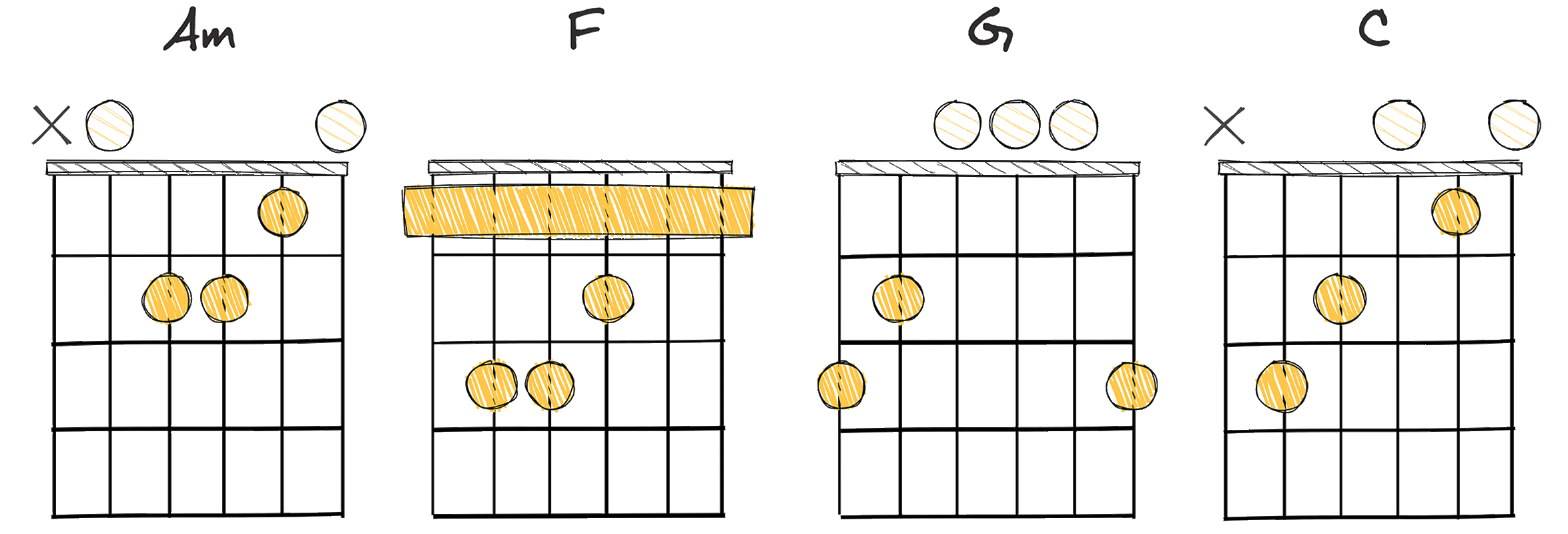
Folk music has always had a strong bond with emotion and storytelling, using simple elements such as vocal harmonies and lyricism to connect with audiences.
Instrumental to this is the use of chord progressions.
The vi – IV – V – I (6- 4- 5- 1) chord progression is a popular choice in this genre.
This progression, often done in the key of C as Am – F – G – C, is noted for its resonating, emotional core.
The reason for this lies in both the history of this progression and its commonality in folk music.
Historically, the vi – IV – V – I progression can be considered a staple in the music world, making its mark in multiple genres, including classical, rock, pop, and of course, folk music.
The progression’s long-standing history contributes to its recognition in the listener’s ear.
Furthermore, the simplistic structure of this progression makes it perfectly suitable for beginners and is thus easy to play.
Embellishments and variations can be added over time as skills improve, however, the beginner can start creating beautiful, emotional sounds right away with this progression.
The Am – F – G – C progression is particularly known for its ability to convey a sense of fulfillment and completion.
This comes from resolving on the tonic chord (I or C in this case) after meandering through the relative minor (vi or Am), the subdominant (IV or F), and the dominant (V or G).
It’s this journey from tension to resolution that can truly infuse emotion into your songs.
I – V – IV – ii (1-5-4-2)
A timeless sequence for evoking deep, melancholic emotions.
This chord progression, starting with the root or primary chord (I), then moving to the dominant or fifth chord (V), followed by the subdominant or fourth (IV) and leading to the second or supertonic (ii), is commonly found in folk music and can add stirring emotion to your songs. The transition from the V to IV and then to ii chords brings a sense of tension and release, creating a melodically pleasing and mellow effect ideal for evoking a poignant mood.
- Difficulty: Easy
- Example: C – G – F – Dm (Key of C)
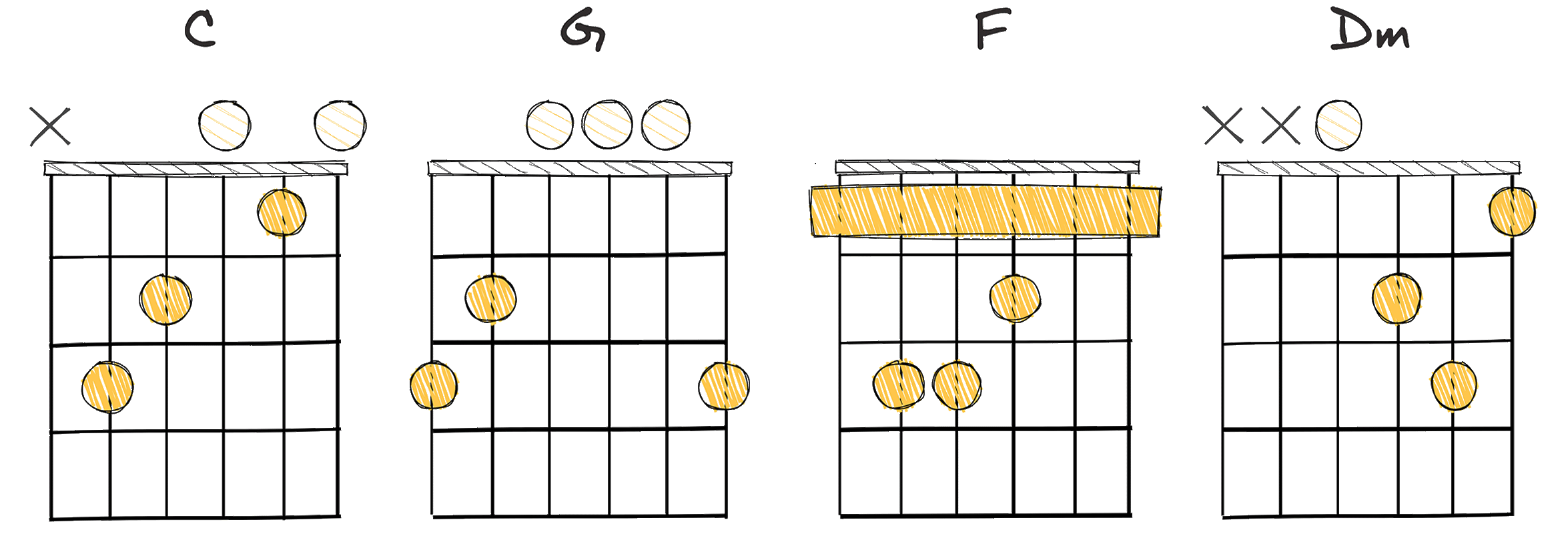
The chord progression I – V – IV – ii is widely employed in a variety of music genres, but it particularly flourishes within folk music.
It represents the chord progression sequence of 1-5-4-2 in its simplest form, commonly associated with the Key of C as C – G – F – Dm.
This chord progression, with its melodious arrangement and harmonic blend of tones, has been used extensively in folk music to infuse a depth of emotion into songs.
The use of this progression tends to create a harmonious, resonant sound that perfectly conveys the raw, emotional essence inherent in folk music.
The notable simplicity of the I – V – IV – ii progression renders it easy for both beginners and experienced musicians to play, thereby contributing to its widespread use in folk music.
Historically, a multitude of celebrated folk songs have incorporated this specific chord progression.
Folk music has always been rooted in poetic storytelling and emotional depth.
These elements are effortlessly complemented by I – V – IV – ii progression’s dynamic nature.
From a musical standpoint, this progression exhibits a beautiful synergy of tension and relief, perfectly reflecting the dichotomy of human emotions present in the realm of folk music.
Moreover, each chord in the progression carries its own expressive strength that can be harnessed to support overarching song themes in folk music.
The IV chord (F in the key of C) delivers a sense of melancholic nostalgia in many instances, whereas the V chord (G in the Key of C) is often viewed as a chord of resolution or homecoming.
Similarly, the ii chord (D minor in the Key of C) often introduces a subtle sense of sorrow, further enhancing the emotional range of the song.
These chords collectively work together within the progression to spawn endless possibilities for emotional expression within the scope of folk music.
Such a progression’s historical application and emotive strength make it an enduring and powerful tool in the creation of memorable folk songs.
Furthermore, the malleable nature of the I – V – IV – ii progression allows for considerable creative freedom, which is a hallmark of folk music composition.
This progression holds a special place in the vast world of music, particularly within the passionate and expressive realm of folk.
ii – IV – vi – V (2-4-6-5)
Capturing melancholy and nostalgia through evocative folk progression.
The ii – IV – vi – V progression is a classic folk chord progression that has a deep, emotional resonance. This progression uses minor chords to create a beautifully melancholic sound that is commonly used in folk music to evoke strong feelings and moods.
- Difficulty: Intermediate
- Example: Bm – D – F#m – E (Key of A)
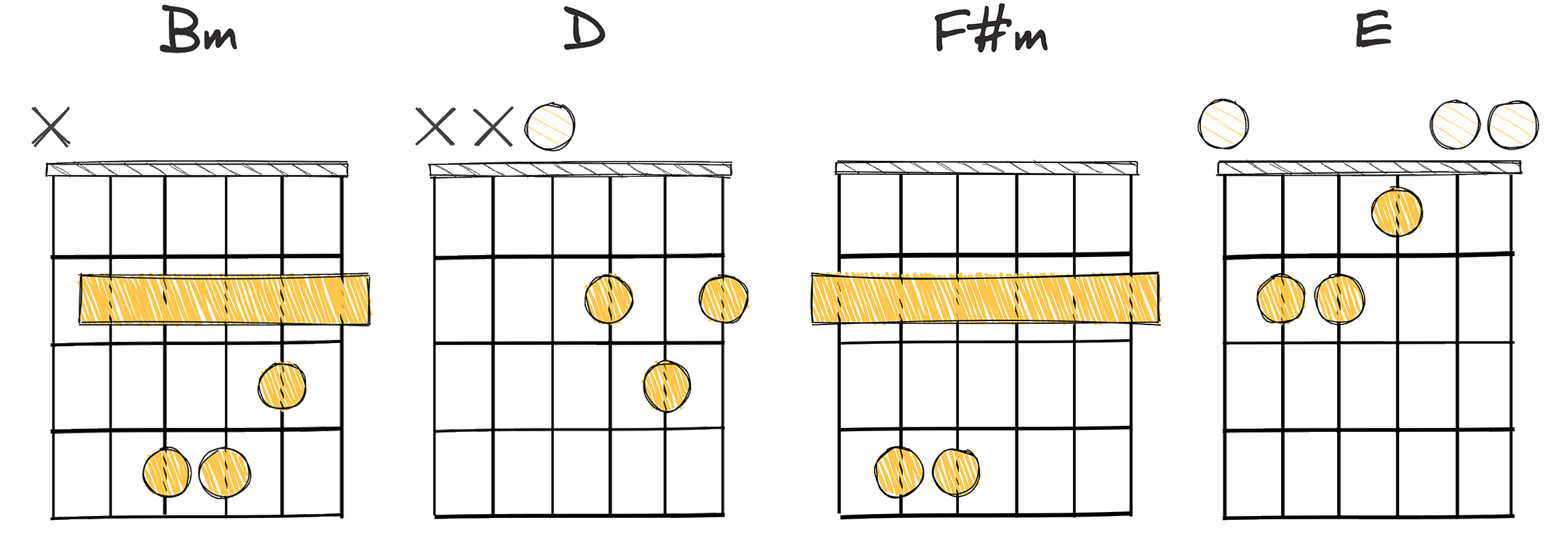
While many popular genres follow common chord progressions, the simplicity and evocativeness of Folk music often calls for subtle alterations that imbue each song with a distinct emotional character.
One such progression that exudes a touch of melancholy, touched with an element of resolve is ii – IV – vi – V (2-4-6-5).
Played in the key of A, this progression translates to Bm – D – F#m – E, an evocative sequence that can work exceptionally well with moving ballads.
This progression, while not as common as I – IV – V or I – V – vi, has been known to be used considerably within the realm of Folk, underscoring story-driven narratives with an emotional chord structure.
Historically, Folk chord progressions have been known to borrow from both the major and minor scales, often blurring the lines between happy and sad emotions – a key characteristic that differentiates Folk from other genres.
Opting for a minor chord (ii/Bm) as the starting point, this progression immediately sets up a somewhat somber, brooding mood.
The subsequent major chord (IV/D) arrives as a welcome contrast, providing an unexpected brightening of the mood.
However, the overall impression is more of a plaintive yearning than overt positivity, introduced through the minor vi chord (F#m), reinforcing the bittersweet mood.
The progression ends on V (E), suggesting a resolution even if it’s not directly “home” to the tonic, which can infuse the song with a sense of wanting, of unresolved tension.
In the realm of Folk music, the emotional nuance that this chord progression can portray is therefore profound – reflective, yet hopeful.
Given that this chord progression requires a certain level of skill to master, it is ideally suited to intermediate players who wish to add depth to their musical expression.
The ability to manipulate chords and progressions to represent certain emotions is a fundamental part of songwriting, and a tool that can significantly enhance the storytelling aspect inherent in Folk music.
Indeed, chord progressions are the structural foundations which melodies and lyrics are built upon, and can ultimately shape the overall feel and direction of a song.
IV – V – I – vi (4-5-1-6)
Classic, emotive progression provides powerful resolution and unexpected melancholy.
This classic folk chord progression, IV – V – I – vi, creates a deeply emotive and haunting narrative that can be found at the heart of many traditional folk songs. The succession from the subdominant (IV) to the dominant (V), resolving on the tonic (I) before transitioning into the relative minor (vi), induces a powerful sense of resolution and melancholy, making it ideal for evoking strong emotions in your music.
- Difficulty: Easy
- Example: C – D – G – Em (Key of G)
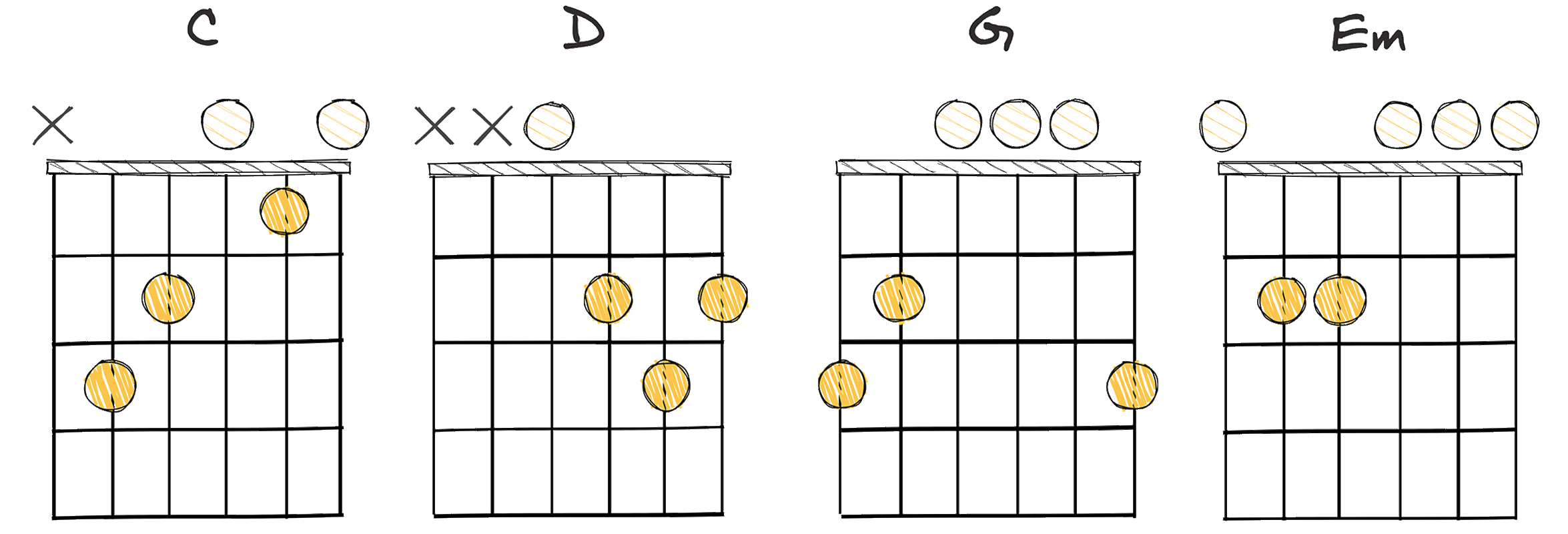
In the world of music, the IV – V – I – vi chord progression holds a significant place.
It is often used in folk music for its ability to evoke rich and intricate emotions.
A historically preferred chord progression, IV – V – I – vi is also easy on the fingers of the guitarists, thus making it widely popular.
Given the simplicity to play and the depth of emotion it offers, it is hardly surprising that this chord progression has been the choice of many musicians over the years.
This classic progression has found its place in some of the most famous folk songs.
The simplicity of the chord progression does not compromise the complexity of emotion it infuses into the song.
The transition from Major (C and D) to G major, the tonic of the key, which then changes drastically to the relative minor (E minor), ingrains an aura of emotional complexity into the song.
This progression represents a clear example of the use of primary and relative chords within a key.
The blending of major and minor chords creates a tonal contrast that is immediately felt by the listener, further enhancing the emotional qualities of the song.
Even though this progression is simple in theory, the application and emotional richness it brings to a composition are in no way trivial.
Whether it is a foot-tapping folk tune or a heart-wrenching ballad, the IV – V – I – vi chord progression finds its place effortlessly, making it a cornerstone in music composition.
The emotional connection that musicians can establish with their audience, using such straightforward chord progressions, are what make songs timeless and unforgettable.
Therefore, the IV – V – I – vi sequence is not simply a chord progression – It is a tool to express and provoke emotions.
The Bottom Line
Ultimately, these chord progressions, varying from the very common I-V-vi-IV to the less utilized ii-Iv-vi-V, demonstrate the diverse range of emotions and tempos that can be delivered in music composition.
Each pattern carries its unique essence, building tension and release while conveying shifting moods and dynamics.
The versatility provided by these combinations offers infinite possibilities for songwriters and musicians, enabling them to express their creativity and leaving profound impacts on listeners.
Therefore, one might conclude that understanding and mastering these chord progressions is not only essential to the fundamental knowledge of music theory, but also crucial to creating compelling and emotionally engaging music.
In love with guitars, and gear; expert in all things music! Been writing about guitars for about 5 years and counting. Born in the ’90s. Alma Mater: University of Havana. Always curious, trying to understand the world. #TeamFender




